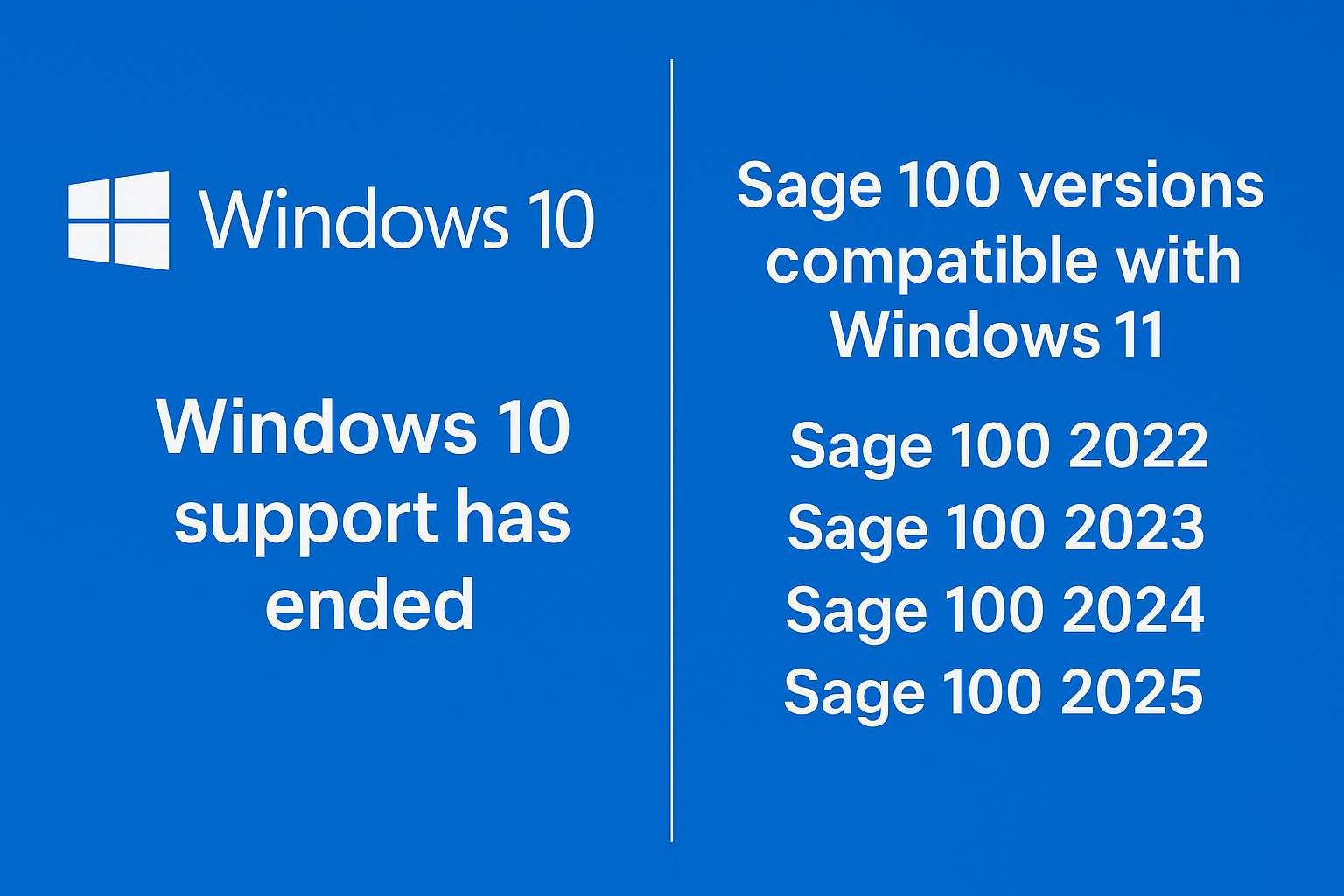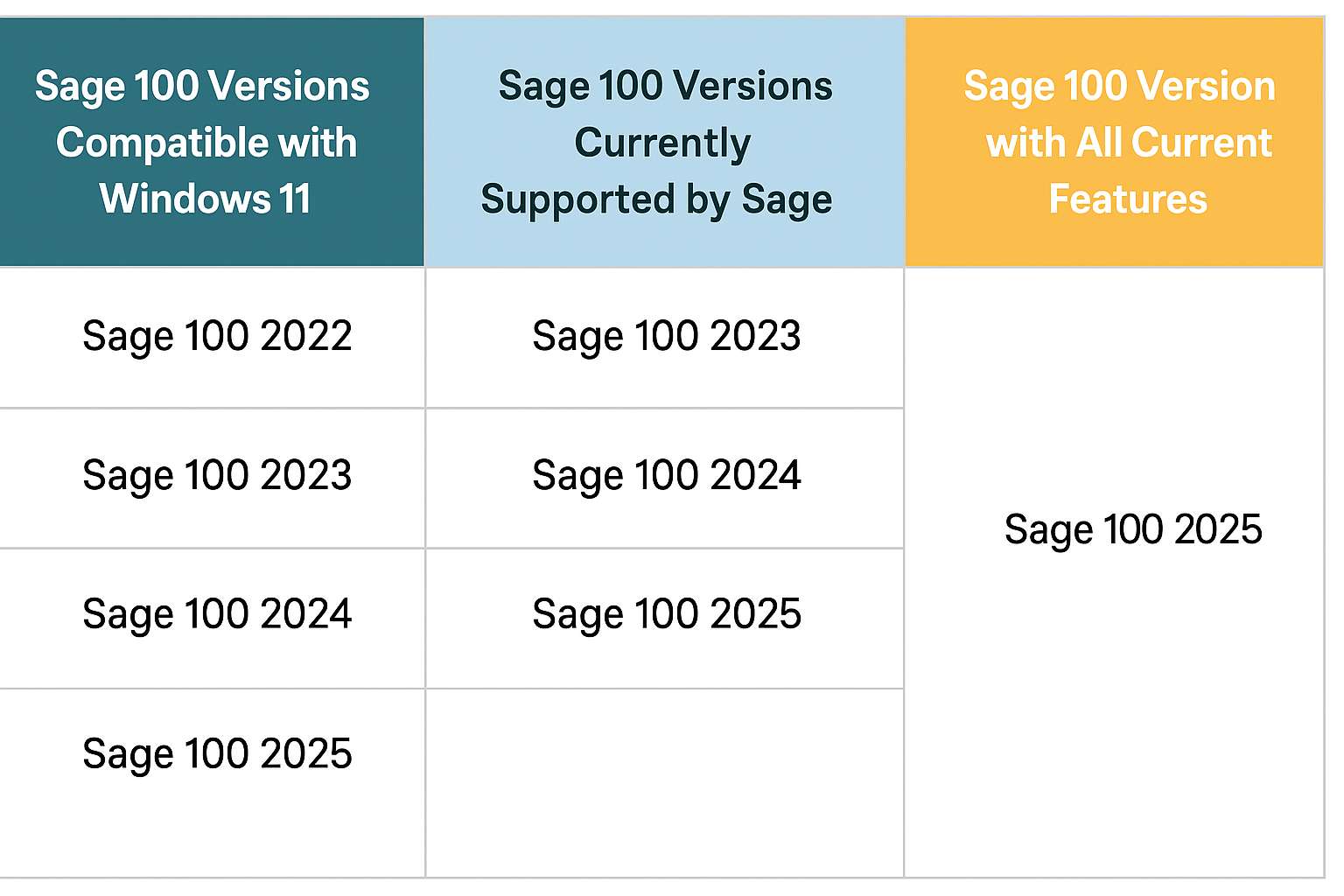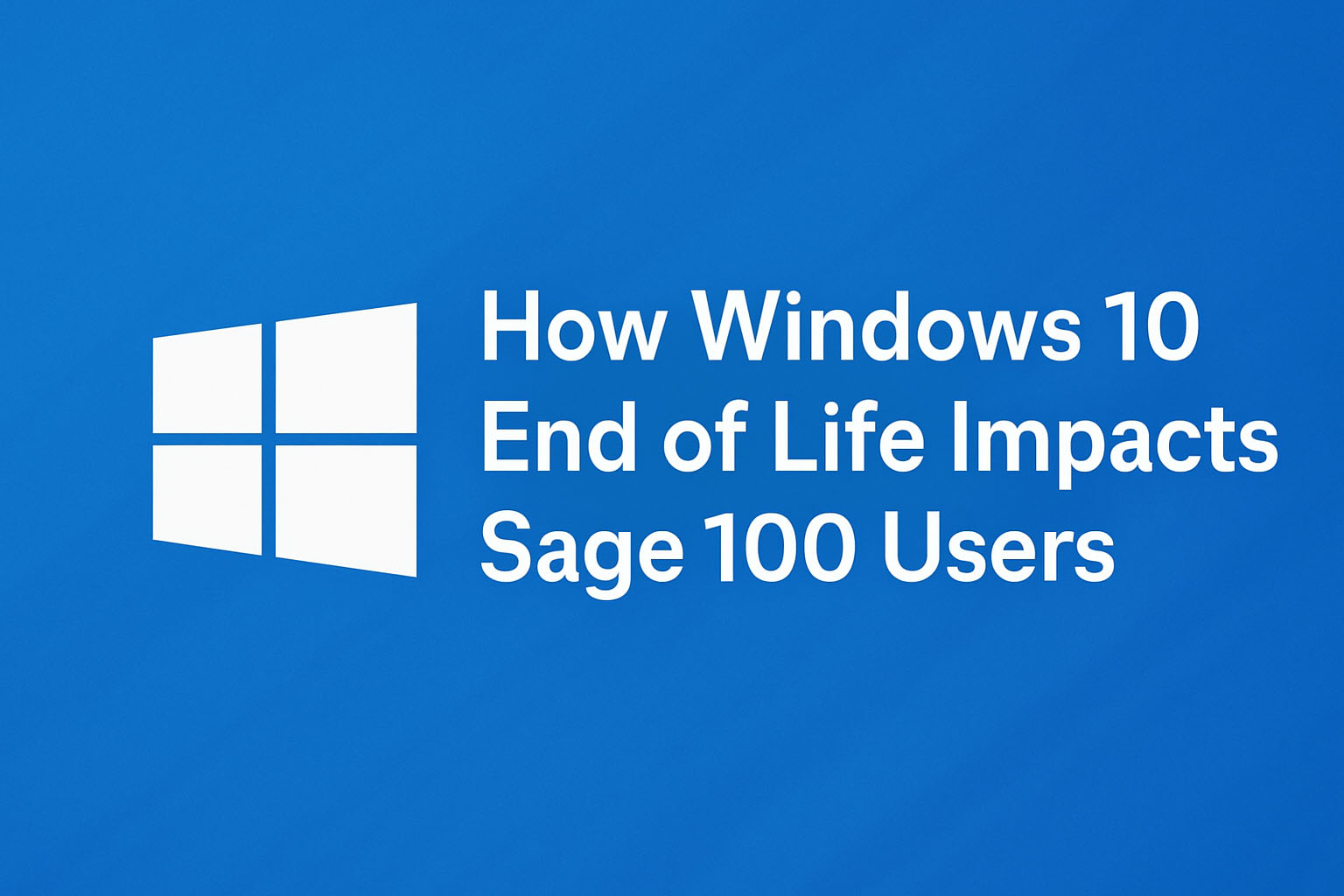Customer Q&A: Sage 100 Users and Windows 10 EOL
Windows 10 support has ended—what does this mean for my Sage 100?
As of October 14, 2025, Microsoft stopped providing technical assistance, feature updates, and security updates for Windows 10. In practical terms, if you continue running Sage 100 on a Windows 10 PC, that PC won’t get critical security patches anymore – leaving it more vulnerable over time. Furthermore, Sage will gradually phase out official support for running Sage 100 on Windows 10. In fact, Sage has indicated that after October 14, 2025, Sage 100 is no longer officially supported on Windows 10 for new updates or versions. You can still use your Sage 100 on Windows 10 for now (nothing will suddenly stop working today), but it will become an increasingly risky and unsupported setup. The bottom line: it’s time to start planning your move to a supported operating system (Windows 11) to keep your Sage 100 environment secure and fully supported.
Can I keep using Windows 10 a bit longer if I can’t upgrade right away?
You can, but proceed with caution. After end-of-life, Windows 10 will continue to run, and Sage 100 will still function on it – there’s no automatic shutdown. Microsoft even offers an Extended Security Updates (ESU) program that you can purchase to get critical security patches for Windows 10 beyond the EOL date. Sage has noted that it will continue to offer help to customers using Sage 100 on Windows 10 during this extended support period. However, these measures are temporary lifelines, not long-term solutions. Running an out-of-date OS means increasing security vulnerabilities with each passing month. Even with paid ESU, you’re only buying a little time (Microsoft typically limits ESU to about 3 years post-EOL). Plus, future Sage 100 updates won’t be tested on Windows 10, so you could encounter compatibility issues down the road. Our advice: if you must stay on Windows 10 a bit longer, do so only as a short-term stopgap. Plan for an upgrade as soon as you can to avoid unwelcome surprises.
Is my version of Sage 100 compatible with Windows 11?
It depends on your Sage 100 version. Sage 100 version 2022 and later are officially compatible with Windows 11. That means if you’re on Sage 100 v2021 or any older release, those versions are not supported on Windows 11 and will likely run into issues. In other words, Sage 100 v2022 was the first version designed to work on Windows 11. If your Sage 100 is older than that, you’ll need to plan a Sage 100 upgrade before moving your operating system to Windows 11. Even if you are on Sage 100 v2022, note that Sage’s support policy only covers the current version and two previous versions (as of now, that’s Sage 100 2025, 2024, and 2023). So while v2022 will run on Windows 11, it’s no longer under Sage’s official support umbrella. For the smoothest experience, we recommend using a Sage 100 version that is both Windows-11-compatible and still supported by Sage (for example, v2023, v2024, or v2025). If you’re running an older Sage 100 release, it’s definitely time to consider a Sage 100 upgrade alongside your move to Windows 11.

Do I really need to upgrade my Sage 100 software now?
If your current Sage 100 version is out of date (especially older than v2022), then yes – upgrading Sage 100 is highly advisable. Upgrading ensures your software stays compatible with modern operating systems and continues to receive support from Sage. Beyond compatibility, there are several benefits to a Sage 100 upgrade. You’ll maintain official Sage 100 support (critical if you run into any issues), and you’ll get the latest security enhancements, bug fixes, and product improvements that have been added in recent releases. Running the latest version reduces the risk of unexpected downtime or “catastrophic” failures due to unpatched security vulnerabilities or old compatibility conflicts. In short, an upgrade keeps your system secure, stable, and efficient. We understand that upgrading software can feel daunting, but Sage 100’s newer versions are designed to work better with Windows 11 and have improvements that can actually make your day-to-day tasks easier. It’s a move that will pay off in smoother operations and peace of mind.

What should I do now to prepare, and how do I upgrade?
Here are some next steps we recommend:
- Assess your current setup: Find out which Sage 100 version you’re on and what operating systems your computers are running. This will determine your upgrade path (e.g., moving from Sage 100 2019 on Windows 10 will be a bigger jump than Sage 100 2023 on Windows 10).
- Review Sage 100 system requirements: Check the Sage 100 Supported Platform Matrix for the version you plan to upgrade to. This document lists the official system requirements and compatible operating systems for Sage 100. Make sure your server and workstations meet the requirements (for example, you’ll want a 64-bit Windows 11 if you’re going to Sage 100 2025, along with required components like .NET Framework 4.8).
- Plan your Windows 11 transition: Identify which PCs need to be upgraded to Windows 11. Some older machines might not meet Windows 11’s hardware requirements. For those, you might need to budget for replacements or consider the temporary ESU route if immediate replacement isn’t feasible.
- Schedule the Sage 100 upgrade: Coordinate with your IT team and Sage business partner to get the upgrade done. It’s wise to do the operating system update and the Sage 100 software update in tandem, so everything stays compatible. Plan it for a time that minimizes disruption (maybe after hours or over a weekend).
- Backup and test: Before making big changes, back up your Sage 100 data. After upgrading, test that Sage 100 and all its modules (e.g. Payroll, integrations) are working correctly on Windows 11. This ensures there are no surprises when you go live.
- Leverage expert help: If you’re unsure about any step, don’t hesitate to reach out to a Sage 100 consultant or your Sage partner for guidance. Upgrading can be straightforward with the right help – we do this every day for clients, and we’re here to make sure it goes smoothly.
The sooner you upgrade, the sooner you’ll be safely on supported systems. But you can tackle it in stages with proper planning. Remember, staying on Windows 10 indefinitely is not worth the mounting security risks and loss of Sage 100 support. A well-planned upgrade now will save you headaches later.
Who can help me?
You don’t have to figure this out alone. If you already work with a Sage business partner, now is a great time to reach out—they can guide you through the process of upgrading Sage 100, planning your Windows 11 transition, and making sure everything stays supported. But if you don’t have a Sage partner or aren’t sure where to turn, Kissinger is here to help. We specialize in Sage 100 support, upgrades, and system planning, and we’ve helped hundreds of companies navigate changes just like this. Whether you need advice, technical assistance, or a full upgrade strategy, our team can make the process simple, stress-free, and tailored to your business.
Technical Deep Dive: Sage 100 Compatibility After Windows 10 EOL
For those who want a deeper technical look (or need some facts to reassure your IT team), this section provides more specifics about Sage 100 compatibility and the Windows 10 end-of-life impact. We’ll go into the exact details of version support, timelines, and requirements. (Feel free to skip to the conclusion if you’ve got what you need from the Q&A above!)
Windows 11 Compatibility by Sage 100 Version:
According to Sage’s official compatibility matrix, only Sage 100 version 2022 and later are supported on Windows 11. Older versions (Sage 100 2021 and earlier) were not designed for Windows 11 and are not on the supported list. This means if you attempt to run, say, Sage 100 2018 or 2020 on Windows 11, you’re in uncharted (and unsupported) territory – it’s likely to encounter issues, and Sage won’t provide fixes for those. Upgrading to at least v2022 (or newer) is necessary for a supported Windows 11 deployment of Sage 100.
Sage 100 support policy (current vs. older versions):
Sage typically supports the current release and two prior releases of Sage 100 at any given time. As of late 2025, the current version is 2025, so the supported versions are 2025, 2024, and 2023. Sage 100 v2022, while compatible with Windows 11, is no longer under Sage’s official support (since it’s more than two versions behind the latest). And anything older than v2022 is both unsupported and incompatible with the newest operating systems. If you’re on an older version, you’re running a double risk (out-of-date OS and out-of-date ERP software). The safest approach is to upgrade to a supported Sage 100 version so you have full vendor support going forward.
Future Sage 100 releases and Windows 10:
Looking ahead, Sage has made it clear that starting with Sage 100 2026 (and other updates scheduled for April 2026), they will not verify or test Sage 100 on Windows 10 at all. In other words, once the 2026 version and late-2025 updates roll out, they assume customers are on Windows 11 (or a supported OS) and will optimize for that environment. If you tried to run those future releases on Windows 10, you’d be in an unsupported configuration. Sage explicitly advises that if you’re on Windows 10 now, you should upgrade your operating system before installing Sage 100 2026.0, or even the upcoming 2025.2 or 2024.4 updates, to ensure everything stays compatible. This is a gentle warning that Windows 10’s grace period for Sage 100 is ending. Essentially, by early 2026, continuing with Windows 10 will not only be risky but could block you from applying important Sage 100 updates or upgrades.
Extended Security Updates (ESU) option:
Microsoft’s Extended Security Updates program for Windows 10 is a paid service that provides critical security patches beyond the official end-of-life. It’s primarily meant for organizations that need a bit more time to transition to a new OS. If you enroll in ESU, you can keep getting Windows 10 security updates for up to three years after 2025. From Sage’s perspective, they have stated that they will continue to offer support to Sage 100 customers on Windows 10 during the ESU period. That means if you’ve paid Microsoft for extended Windows 10 updates and you run into a Sage 100 issue, Sage support won’t immediately turn you away just because you’re on Windows 10. However, be aware: ESU is a stop-gap. It doesn’t provide new features or full product support – it just extends security patching. And it’s not cheap, especially for small businesses. Use it only if you truly cannot move to Windows 11 in time. The recommended path is still to upgrade your OS and software rather than relying on ESU.
Sage 100 system requirements and best practices:
As you plan your upgrades, always refer to the official Sage 100 System Requirements/Supported Platforms Matrix for your version. This will ensure your hardware, operating system, and related components meet Sage’s guidelines. A few technical notes to keep in mind:
- .NET Framework 4.8: Sage 100 (especially recent versions like 2025) requires Microsoft .NET Framework 4.8 to be installed on the system. Both Windows 10 and Windows 11 support .NET 4.8, and in many cases it’s already present. If not, the Sage 100 installer will prompt you to install .NET 4.8 and a reboot may be required. This is a one-time setup step to ensure Sage 100 runs properly.
- 32-bit vs 64-bit Sage 100 on Windows 11: Sage 100 version 2025 is available in both 32-bit and 64-bit editions. If you’re moving to Windows 11, Sage recommends using the 64-bit edition of Sage 100. The reason is that the 32-bit Sage 100 has some known issues on newer operating systems (for example, Sage noted unresolved issues with the Windows print spooler when using Sage 100 2025 32-bit on Windows 11). The 64-bit version doesn’t have that problem and is better optimized for modern 64-bit OS environments. In short, if you have a choice (and your third-party add-ons or customizations support 64-bit), go with 64-bit Sage 100 on Windows 11 for the best stability.
- Server considerations: If your Sage 100 is used in a client-server setup, also ensure your server OS is supported (e.g. Windows Server 2019, 2022, or 2025 for Sage 100 2025, per Sage’s compatibility matrix). While the Windows 10 EOL primarily affects workstations, it’s good practice to keep server operating systems updated and within support as well. Sage 100 is supported on modern Windows Server editions (2016, 2019, 2022, etc.), but older servers may need upgrades in the coming years as well. And remember, Sage 100 does not support running over peer-to-peer networks or non-server OS for hosting – you’ll want a proper server environment if you have multiple users.
We hope this technical deep dive helps clarify the details for those who needed the specifics. Keeping track of version compatibility and support matrices can be a lot, but the big picture is: stay on supported software and systems to minimize issues.
Conclusion
Windows 10’s end-of-life in 2025 is a significant milestone, but it doesn’t have to be a crisis. With a bit of planning and timely action, you can ensure your Sage 100 compatibility remains intact and your business operations continue without a hitch. The key takeaways are clear: upgrade to Windows 11 (or a supported OS) as soon as you can, and make sure your Sage 100 software is up-to-date so that it’s compatible and fully supported in this new environment. By doing so, you’ll maintain Sage 100 support, strengthen your security posture, and position your company to take advantage of the latest Sage 100 features and improvements.
We understand that changes like these can feel overwhelming – after all, you have a business to run. But you’re not alone. If you need help or have questions specific to your situation, reach out to your Sage business partner or IT advisor. As a team that works with Sage 100 users every day, we’re here to offer guidance and hands-on assistance with any Sage 100 upgrade or Windows transition you might need. Our goal is to make the process as smooth and stress-free as possible.
In the end, staying current with your software and systems is the best way to protect your business and set yourself up for success. Windows 10 had a great run, but now it’s time to embrace the next chapter. With Windows 11 and the latest Sage 100 by your side, you’ll be well-equipped for the future – with a secure, supported, and efficient system powering your operations. Here’s to a smooth upgrade journey, and as always, we’re here to help if you need us. Good luck with your upgrades, and thank you for reading!








